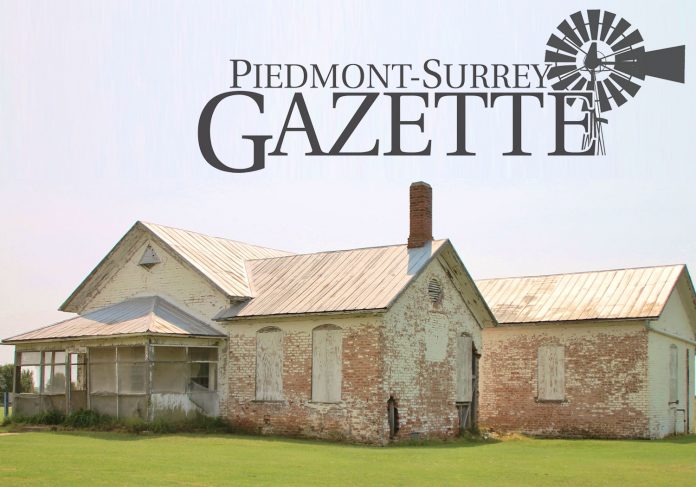
By Carol Mowdy Bond
Contributing Writer
Since March, the U.S. Department of Agriculture bulldozed up to nine structures at Fort Reno, purportedly due to lack of maintenance, safety issues, and the dilapidated state of the structures. Sitting on historic Route 66, just a few miles northwest of El Reno in Canadian County, the fort was home to the 9th and 10th Cavalry known as Buffalo Soldiers.
The USDA did not respond to questions about the bulldozing work.
Those who work at Fort Reno claim eight or nine buildings were bulldozed during the ongoing pandemic shut down of the fort. And USDA documents show that the following have already or will be bulldozed: Machine Shop; Hay Barn; Coal House B19; Coal House B20; Coal House B5; Coal House B16; Coal House B9; and Garage by Bakery.
Fort Reno’s curator Wendy Ogden said that during the summer, she went into a fort building to deal with paperwork. Two USDA agents approached her and questioned her extensively as to why she was on the property. During the conversation, those agents told Ogden that buildings yet to be bulldozed include, at the very least, the Ben Clark Home, the bakery, the guard house/jailhouse, and the seven Soap Suds Row homes. As well, Ogden had a conversation with an equipment operator on the fort grounds, who was part of the bulldozing process, and he claimed the Ben Clark Home is on the list to be demolished.
Sen. James Inhofe said, “Over the past few weeks, I’ve heard from members of the Fort Reno community who are concerned about the demolition of buildings at historic Fort Reno. I understand their frustration. It appears that the USDA and the State Office of Historical Preservation have not done a good job of communicating the process, timing and action being taken. Some of the buildings are in extreme disrepair at Fort Reno, but that doesn’t excuse poor communication with community stakeholders. Going forward, the planned demolition has been halted so stakeholders can discuss all options for further preservation. Furthermore, I urge both entities to rededicate their efforts to informing the community about any planned actions to promote the longevity of historic Fort Reno, as well as the USDA mission.”
For clarification purposes, in layman’s terms, history is the study of past events. And the word historic often refers to something, some place or someone in history that/who was famous, notable, celebrated.
However, it appears that in Oklahoma, the State Office of Historical Preservation , and the USDA define a historic structure or location a bit differently. It appears, at this juncture of this story, that they possibly define those terms as they relate to the National Register of Historic Places, and/or possibly some other source.
Contacted, by phone calls and emails, Linda Ozan, Deputy State Historic Preservation Officer at the Oklahoma Historical Society, said that answering questions on demolition of Fort Reno structures is up to the USDA, as they are the entity in charge of the demolition.
But off the top of her head, she did recall that future demolition will include the Ben Clark, the guardhouse, and the seven Soap Suds Row houses.
The National Register of Historic Places is the nation’s catalog of buildings, structures, sites, districts, and objects significant in American history, architecture, archaeology, engineering or culture, maintained by the Secretary of the Interior under authority of the National Historic Preservation Act. The NRHP is the official list of the nation’s historic places worthy of preservation.
Fort Reno is listed on the National Register. It is a federal installation. And last month, members of the Historic Fort Reno Board Inc. or HFRBI began sounding alarms about demolition of buildings at the fort without their knowledge.
Of its many buildings, Fort Reno has four venues that are normally accessible to visitors, including the fort’s museum, the Cavalry Museum, the BlueSTEM AgriLearning Center, and the chapel. All four are housed in historic fort buildings. However, those buildings have remained closed since March.
When COVID-19 hit, Oklahoma shut down historic venues in March, including historic Fort Reno. Many of the state’s historic sites reopened to visitors, at least partially, early in the summer. But apparently the USDA will not allow Fort Reno’s buildings to reopen, telling Fort Reno staff that COVID-19 requires the continued shut down.
Ogden, and Marie Hirst, president of Historic Fort Reno Board Inc or HFRBI, puzzled as to why the fort’s buildings remained closed. They said USDA officials told them the COVID-19 pandemic required the continued closure. During the summer, Hirst and Ogden went into the buildings. They wanted to make sure the electricity was still on, and that archival items remained cool enough for preservation purposes, and take care of paperwork.
Ogden and Hirst said they discovered eight or nine historic buildings on the fort grounds were gone. Since the March closure, the USDA bulldozed the buildings, and dirt and rubble are all that remained. As well, they said USDA crews used lawn equipment to desecrate numerous historic grave markers during the month of August.
The Historic Fort Reno Board Inc., is a nonprofit organization that preserves and uses historical and cultural resources at Fort Reno. Members of the board are volunteers, serving with no pay, except for Ogden who is paid by HFRBI. Their mission is to secure funding for restoration of historic structures, the visitor’s center and museum operations and activities, educating the public through historical interpretation, and establish partnerships necessary for the long-term stability of the organization. All funding is raised by fundraising efforts, grants and donations. At this time, there are no state or federal funds available for the fort.
Senator Inhofe’s sources said their findings are that the buildings that have been demolished so far are not historic structures.
Apparently, the USDA bulldozed buildings because they are dilapidated and are unsafe. They are purportedly considered to be ancillary buildings, meaning buildings that are subordinate to and not forming an integral part of the main or principal building(s). But, visitors have been allowed to enter the fort grounds and walk around, despite buildings that appear to be unstable and unsafe on the grounds.
Inhofe’s sources also said there are eight historic buildings that USDA plans to demolish because they are unsafe, but, based on oversight efforts, the proper notification procedures appear to have been followed.
However, as of this date, eight or nine buildings are already gone.
The disagreements and disconnect in communication, between government agencies and the Fort Reno community, including the curator, board and citizens who love the fort, seem to center around several documents and a lack of communication between concerned parties. These documents include an October 2017 USDA document, and a December 2017 document that assessed the safety of the buildings at Fort Reno and explained plans to demolish buildings, plus a Memorandum of Agreement between USDA, the State Historic Preservation Office and the State Archaeologist.

Senator Inhofe’s sources also said that upon being asked, USDA shared the email they sent to the designated contact for the Tribal Historic Preservation Office for the Cheyenne and Arapaho Tribes in October of 2019. Also, USDA was required to inform the signatories of the Memorandum of Agreement and tribal partners about the agreement. But again, as alluded to in Inhofe’s quote, could have been proactive in working with SHPO or reaching out to local historical organizations and the public.
The sources also said that Sen. Inhofe has always supported historic Fort Reno. Indeed, his 2005 legislation would have been used to fund repair and future maintenance at the site, not for private use.
Nearly 200 people are buried in the Fort Reno Cemetery. Of those graves, about two-thirds were buried during the 1800s. The earliest grave is said to be marked 1874.
Hirst said the fort averages 10,000 visitors each summer, and they come from across the globe. As well, the fort hosts school tours, and other events meant to keep history alive. Also, there are learning centers on the fort grounds.
Hirst also said the USDA has funding for the restoration and preservation of the fort’s buildings. But she said the USDA has not used that funding for those purposes. She also said she found contractors willing to do restoration work at no charge. But the USDA would not allow that work to go forward.
Through time, the fort hosted numerous famous visitors. The famous aviatrix Amelia Earhart flew her autogiro, a forerunner of the helicopter, at the Fort Reno airstrip in 1931.
Will Rogers often visited the fort to watch polo matches and horse races. And the famous American painter, illustrator, sculptor, and writer Frederic Remington, born in 1861, spent three months in residence at the fort. He used individuals there as inspiration for various of his creations.





